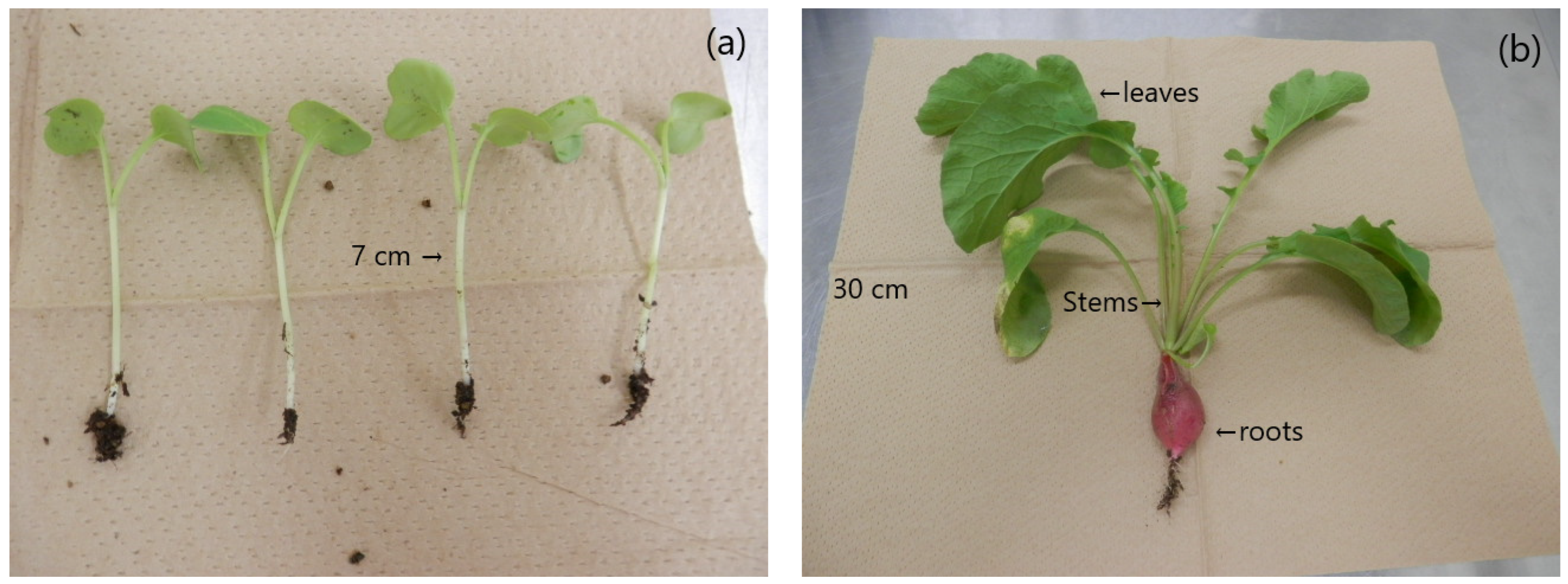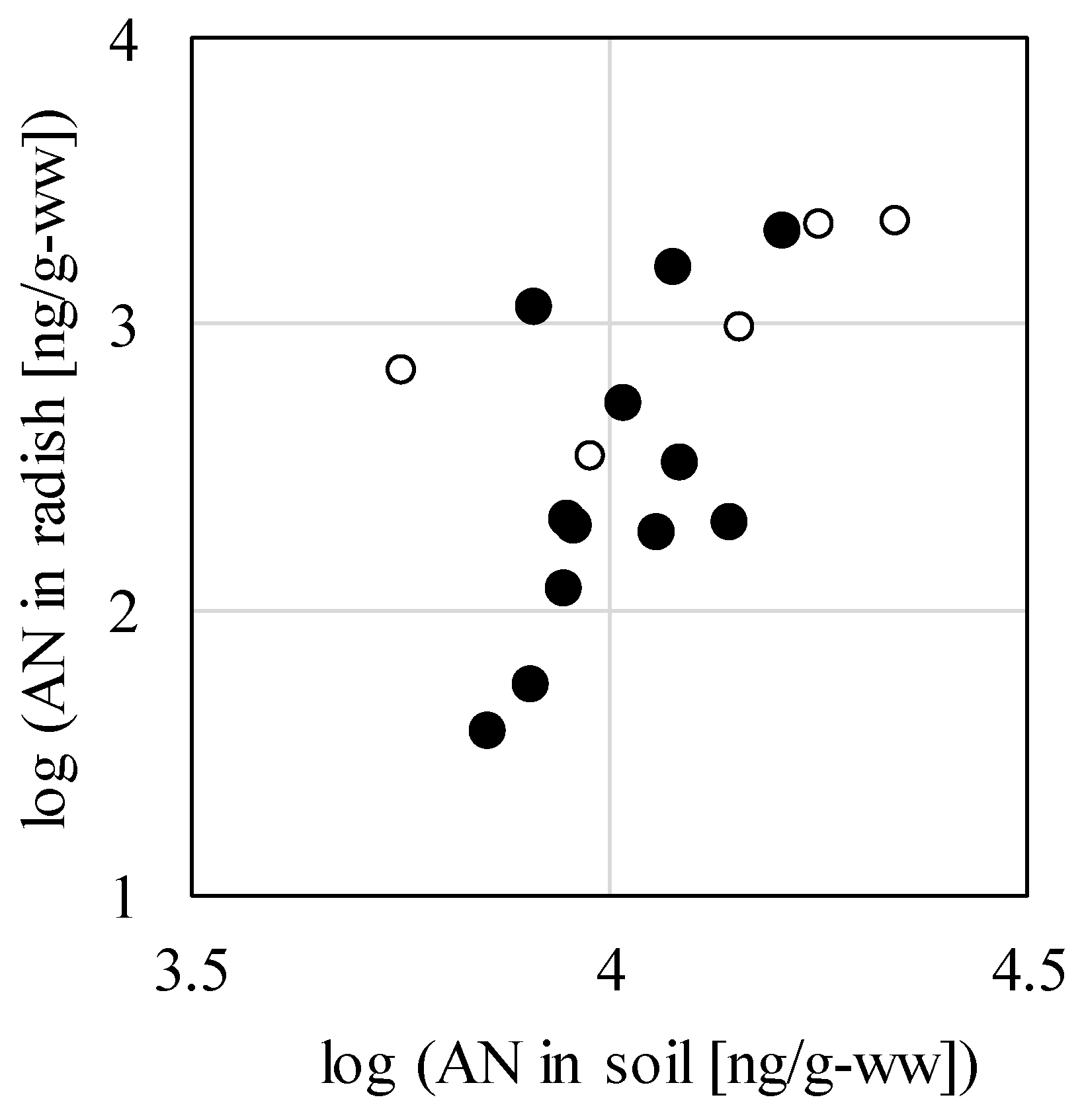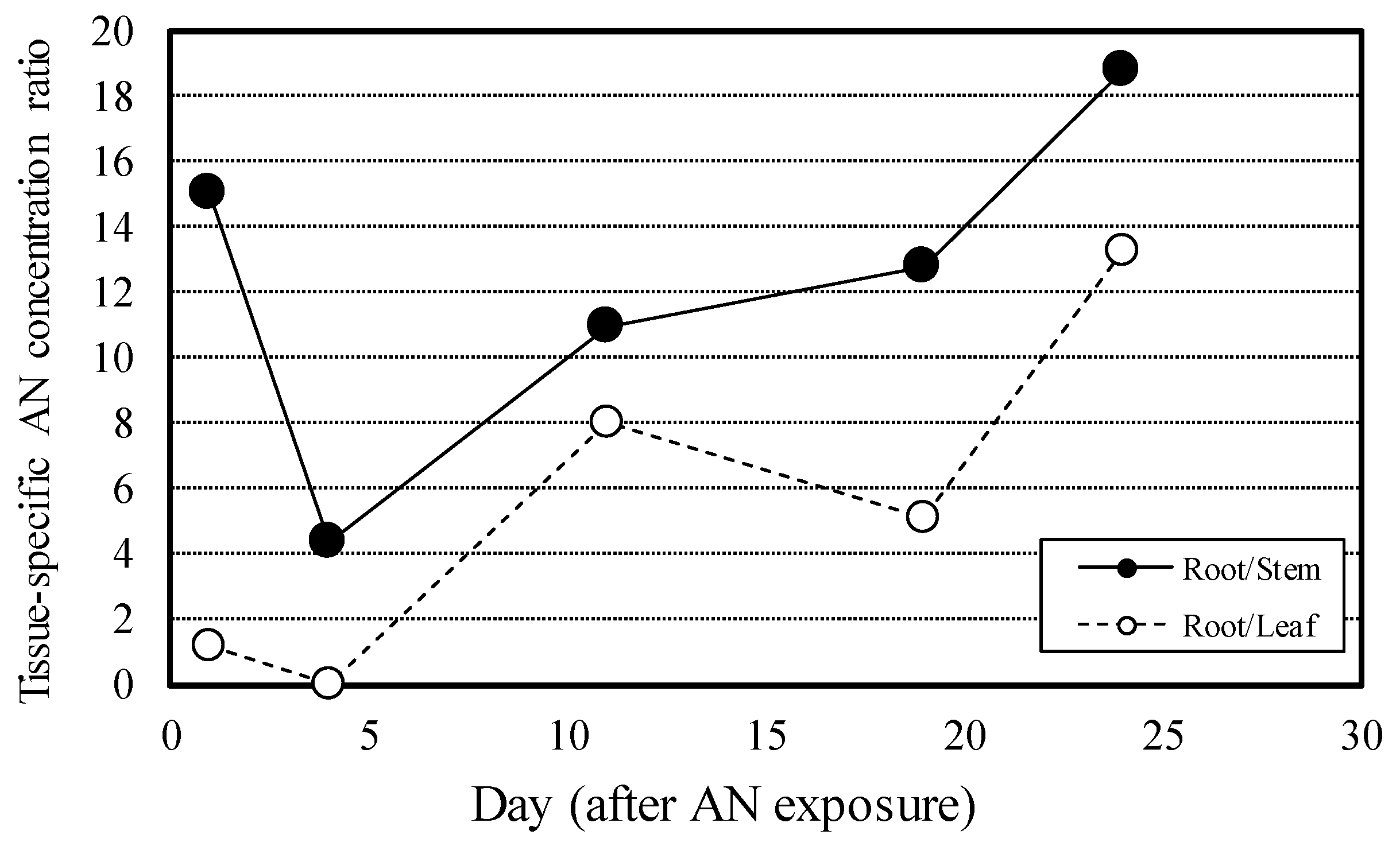Anthracene Absorption and Concentration Dynamics in Radishes
Abstract
1. Introduction
2. Materials and Methods
2.1. Chemicals
2.2. Plant Material and Radish Growth
2.3. Experimental Conditions
2.4. Sampling of Specimens
2.5. Analysis of Anthracene
3. Results
3.1. Results for Radishes Grown from Sowing Onward in Soil Contaminated with Anthracene
3.2. Results for Radishes Grown after Maturity in Soil Contaminated with Anthracene
4. Discussion
4.1. Relationship between Anthracene Concentration in Soil and Concentration in Radishes
4.2. Concentration Ratio and Content Composition Ratio of Anthracene by Radish Part
5. Conclusions
Funding
Institutional Review Board Statement
Informed Consent Statement
Data Availability Statement
Conflicts of Interest
References
- Shen, H.; Tao, S.; Wang, R.; Wang, B.; Shen, G.; Li, W.; Su, S.; Huang, Y.; Wang, X.; Liu, W.; et al. Global time trends in PAH emissions from motor vehicles. Atmos. Environ. 2011, 45, 2067–2073. [Google Scholar] [CrossRef]
- Aydin, Y.M.; Kara, M.; Dumanoglu, Y.; Odabasi, M.; Elbir, T. Source apportionment of polycyclic aromatic hydrocarbons (PAHs) and polychlorinated biphenyls (PCBs) in ambient air of an industrial region in Turkey. Atmos. Environ. 2014, 97, 271–285. [Google Scholar] [CrossRef]
- Satri, E.; Pasti, L.; Scaroni, I.; Casali, P.; Cavazzini, A.; Rossi, M. Determination of n-alkanes, PAHs and nitro-PAHs in PM2.5 and PM1 sampled in the surroundings of a municipal waste incinerator. Atmos. Environ. 2017, 149, 12–23. [Google Scholar] [CrossRef]
- Lin, Y.C.; Li, Y.C.; Shangdiar, S.; Chou, F.C.; Sheu, Y.T.; Cheng, P.C. Assessment of PM2.5 and PAH content in PM2.5 emitted from mobilesource gasoline-fueled vehicles in concomitant with the vehicle modeland mileages. Chemosphere 2019, 226, 502–508. [Google Scholar] [CrossRef] [PubMed]
- Thang, P.Q.; Kim, S.J.; Lee, S.J.; Ye, J.; Seo, Y.K.; Baek, S.O.; Choi, S.D. Seasonal characteristics of particulate polycyclic aromatic hydrocarbons (PAHs) in a petrochemical and oil refinery industrial area on the west coast of South Korea. Atmos. Environ. 2019, 198, 398–406. [Google Scholar] [CrossRef]
- Ong, P.T.; Yong, J.C.; Chin, K.Y.; Hii, Y.S. Bioaccumulation and depuration of anthracene in Penaeus monodon (Fibricius) through food ingestion. Chemosphere 2011, 84, 578–584. [Google Scholar] [CrossRef] [PubMed]
- Zhou, C.; Zhu, X.; Wang, Z.; Ma, X.; Chen, J.; Ni, Y.; Wang, W.E.I.; Mu, J.U.N.; Li, X. Gas-Particle Partitioning of PAHs in the urban air of Dalian, China: Measurements and assessments. Polycycl. Aromat. Compd. 2013, 33, 31–51. [Google Scholar] [CrossRef]
- Obrist, D.; Zielinska, B.; Perlinger, J.A. Accumulation of polycyclic aromatic hydrocarbons (PAHs) and oxygenated PAHs (OPAHs) in organic and mineral soil horizons from four U.S. remote forests. Chemosphere 2015, 134, 98–105. [Google Scholar] [CrossRef] [PubMed]
- Subramanian, A.; Kunisue, T.; Tanabe, S. Recent status of organohalogens, heavy metals and PAHs pollution in specific locations in India. Chemosphere 2015, 137, 122–134. [Google Scholar] [CrossRef] [PubMed]
- Evans, M.; Davies, M.; Janzen, K.; Muir, D.; Hazewinkel, R.; Kirk, J.; Boer, D. PAH distributions in sediments in the oil sands monitoring area and western Lake Athabasca: Concentration, composition and diagnostic ratios. Environ. Pollut. 2016, 213, 671–687. [Google Scholar] [CrossRef] [PubMed]
- Adekunle, A.S.; Oyekunle, J.A.O.; Ojo, O.S.; Maxakato, N.W.; Olutona, G.O.; Obisesan, O.R. Determination of polycyclic aromatic hydrocarbon levels of groundwater in Ife north local government area of Osun state, Nigeria. Toxicol. Rep. 2017, 4, 39–48. [Google Scholar] [CrossRef] [PubMed]
- Li, J.; Li, F.; Liu, Q. PAHs behavior in surface water and groundwater of the Yellow Riverestuary: Evidence from isotopes and hydrochemistry. Chemosphere 2017, 178, 143–153. [Google Scholar] [CrossRef] [PubMed]
- Wang, C.; Zhou, S.; Wu, S.; Song, J.; Shi, Y.; Li, B.; Chen, H. Surface water polycyclic aromatic hydrocarbons (PAH) in urban areas of Nanjing, China. Water Sci. Technol. 2017, 76, 2150–2157. [Google Scholar] [CrossRef]
- Pratt, G.C.; Herbrandson, C.; Krause, M.; Schmitt, C.; Lippert, C.J.; McMahon, C.R.; Elickson, K.M. Measurements of gas and particle polycyclic aromatic hydrocarbons (PAHs) in air at urban, rural and near-roadway sites. Atmos. Environ. 2018, 179, 268–278. [Google Scholar] [CrossRef]
- Hazarika, N.; Das, A.; Kamal, V.; Anwar, K.; Srivastaba, A.; Jain, V.K. Particle phase PAHs in the atmosphere of Delhi-NCR: With spatial distribution, source characterization and risk approximation. Atmos. Environ. 2019, 200, 329–342. [Google Scholar] [CrossRef]
- Yang, T.; Cheng, H.; Wang, H.; Drews, M.; Li, S.; Huang, W.; Zhou, H.; Chen, C.M.; Diao, X. Comparative study of polycyclic aromatic hydrocarbons (PAHs) and heavy metals (HMs) in corals, surrounding sediments and surface water at the Dazhou Island, China. Chemosphere 2019, 218, 157–168. [Google Scholar] [CrossRef] [PubMed]
- Robin, S.L.; Marchand, C. Polycyclic aromatic hydrocarbons (PAHs) in mangrove ecosystems: A review. Environ. Pollut. 2022, 311, 119959. [Google Scholar] [CrossRef]
- Alshaheen, K.S.; Al-Naiema, I.M.; Tuama, D.M.; Al-Mosuwi, W.H. Characterization, risk assessment, and source estimation of PM10-bound polycyclic aromatic hydrocarbons during wintertime in the ambient air of Basrah City, Iraq. Chemosphere 2023, 326, 138444. [Google Scholar] [CrossRef]
- Sun, Y.; Liu, L.Y.; Lv, L.L.; Zhou, X.X.; Luo, Y.Y.; Qu, J.Z.; Ma, W.L.; Zhang, Z.F.; Song, L.; Wang, L.; et al. Distribution of polycyclic aromatic hydrocarbons in indoor/outdoor window films and the indoor film/air partition of northeastern Chinese college dormitories. Chemosphere 2023, 322, 138136. [Google Scholar] [CrossRef]
- IARC. Agents Classified by the IARC Monographs, Volumes 1–129; IARC: Lyon, France, 2021; Available online: https://monographs.iarc.who.int/agents-classified-by-the-iarc/ (accessed on 26 December 2023).
- ECHA. Candidate List of Substances of Very High Concern for Authorisation; ECHA: Helsinki, Finland, 2021; Available online: https://www.echa.europa.eu/candidate-list-table (accessed on 26 December 2023).
- Mikes, O.; Cupr, P.; Trapp, S.; Klanova, J. Uptake of polychlorinated biphenyls and organochlorine pesticides from soil and air into radishes (Raphanus sativus). Environ. Pollut. 2009, 157, 488–496. [Google Scholar] [CrossRef]
- Létondor, C.; Pascal-Lorber, S.; Laurent, F. Uptake and distribution of chlordecone in radish: Different contamination routes in edible roots. Chemosphere 2015, 118, 20–28. [Google Scholar] [CrossRef] [PubMed]
- Trapp, S. Calibration of a plant uptake model with plant- and site-specific data for uptake of chlorinated organic compounds into radish. Environ. Sci. Technol. 2015, 49, 395–402. [Google Scholar] [CrossRef] [PubMed]
- Ngo, N.K.; Pinch, B.M.; Bennett, W.W.; Teasdale, P.R.; Jolley, D.F. Assessing the uptake of arsenic and antimony from contaminated soil by radish (Raphanus sativus) using DGT and selective extractions. Environ. Pollut. 2016, 216, 104–114. [Google Scholar] [CrossRef]
- Yang, C.Y.; Chang, M.L.; Wu, S.C.; Shih, Y.H. Partition uptake of a brominated diphenyl ether by the edible plant root of white radish (Raphanus sativus L.). Environ. Pollut. 2017, 223, 178–184. [Google Scholar] [CrossRef] [PubMed]
- Li, Y.; Chuang, Y.; Sallacch, J.B.; Zhang, W.; Boyd, S.A.; Li, H. Potential metabolism of pharmaceuticals in radish: Comparison of in vivo and in vitro exposure. Environ. Pollut. 2018, 242, 962–969. [Google Scholar] [CrossRef]
- Shimazu, H. Diazinon absorption and bioaccumulation in the garden radish (Raphanus raphanistrum ssp. sativus). Int. J. GEOMATE 2019, 17, 188–194. [Google Scholar] [CrossRef]
- Abril, C.; Santos, J.L.; Martín, J.; Aparicio, I.; Alonso, E. Uptake and translocation of multiresidue industrial and household contaminants in radish grown under controlled conditions. Chemosphere 2021, 268, 128823. [Google Scholar] [CrossRef]
- Rhodes, G.; Chuang, Y.; Hammerschmidt, R.; Zhang, W.; Boyd, S.; Li, H. Uptake of cephalexin by lettuce, celery, and radish from water. Chemosphere 2021, 263, 127916. [Google Scholar] [CrossRef]
- Bishnoi, N.R.; Mehta, U.; Pandit, G.G. Quantification of polycyclic aromatic hydrocarbons in fruits and vegetables using high performance liquid chromatography. Indian J. Chem. Technol. 2006, 13, 30–35. Available online: http://nopr.niscpr.res.in/handle/123456789/6992 (accessed on 26 December 2023).
- Bansal, V.; Kim, K. Review of PAH contamination in food products and their health hazards. Environ. Int. 2015, 84, 26–38. [Google Scholar] [CrossRef]
- Premnath, N.; Mohanrasu, K.; Guru Raj Rao, R.; Dinesh, G.H.; Siva Prakash, G.; Ananthi, V.; Ponnuchamy, K.; Muthusamy, G.; Arun, A. A crucial review on polycyclic aromatic Hydrocarbons—Environmental occurrence and strategies for microbial degradation. Chemosphere 2021, 280, 130608. [Google Scholar] [CrossRef] [PubMed]
- Li, Y.T.; Li, F.B.; Chen, J.J.; Yang, G.Y.; Wan, H.F.; Zhang, T.B.; Zeng, X.D.; Liu, J.M. The concentrations, distribution and sources of PAHs in agricultural soils and vegetables from Shunde, Guangdong, China. Environ. Monit. Assess. 2008, 139, 61–76. [Google Scholar] [CrossRef] [PubMed]
- Tuteja, G.; Rout, C.; Bishnoi, N.R. Quantification of polycyclic aromatic hydrocarbons in leafy and underground vegetables: A case study around Panipat city, Haryana. J. Environ. Sci. Technol. 2011, 4, 611–620. [Google Scholar] [CrossRef]
- Kipopoulou, A.K.; Manoli, E.; Samara, C. Bioconcentration of polycyclic aromatic hydrocarbons in vegetables grown in an industrial area. Environ. Pollut. 1999, 106, 369–380. [Google Scholar] [CrossRef]
- Paris, A.; Ledauphin, J.; Poinot, P.; Gaillard, J.L. Polycyclic aromatic hydrocarbons in fruits and vegetables: Origin, analysis, and occurrence. Environ. Pollut. 2018, 234, 96–106. [Google Scholar] [CrossRef]
- Liste, H.H.; Alexander, M. Plant-promoted pyrene degradation in soil. Chemosphere 2000, 40, 7–10. [Google Scholar] [CrossRef]
- Huo, M.; Ma, W.; Zhou, K.; Xu, X.; Liu, Z.; Huang, L. Migration and toxicity of toltrazuril and its main metabolites in the environment. Chemosphere 2022, 302, 134888. [Google Scholar] [CrossRef]
- Hansh, C.; Leo, A.; Hoekman, D. Exploring QSAR—Hydrophobic, Electronic, and Steric Constants; American Chemical Society: Washington, DC, USA, 1995. [Google Scholar]







| Planter No. | Growing Period | Air (°C) | Soil (°C) | AN Amount |
|---|---|---|---|---|
| P1 | 3 June–1 July 2019 | 26.7 | 25.9 | 0.05 g |
| P2 | 3 June–1 July 2019 | 26.7 | 26.9 | 0.10 g |
| P3 | 2 July–30 July 2019 | 28.2 | 28.9 | 0.20 g |
| P4 | 1 June–22 July 2019 | 27.6 | 26.5 | See Section 2.3 |
| Planter No. | AN | Sample Type | Elapsed Time after Seeding | ||||
|---|---|---|---|---|---|---|---|
| 0 Days | 6 Days | 14 Days | 21 Days | 28 Days | |||
| P1 | 0.05 g | Soil | 12,500 | 8040 | 8840 | 7980 | 7140 |
| Radish | 1170 | 214 | 55.4 | 38.2 | |||
| (5.16 g) 23 * | (14.1 g) 17 * | (24.6 g) 5 * | (45.2 g) 3 * | ||||
| Root | 2030 | 374 | 31.8 | ||||
| (1.37 g) | (2.57 g) | (17.3 g) | |||||
| Stem | 2.28 | 1.29 | 47.2 | ||||
| (5.32 g) | (9.86 g) | (13.1 g) | |||||
| Leaf | 33.2 | 32.3 | 37.8 | ||||
| (7.43 g) | (12.2 g) | (14.8 g) | |||||
| P2 | 0.10 g | Soil | 23,300 | 11,900 | 10,300 | 9020 | 8770 |
| Radish | 1620 | 547 | 200 | 122 | |||
| (6.29 g) 27 * | (13.2 g) 14 * | (26.6 g) 6 * | (48.0 g) 3 * | ||||
| Root | 4410 | 2580 | 305 | ||||
| (1.33 g) | (1.37 g) | (15.6 g) | |||||
| Stem | 22.7 | 41.2 | 52.9 | ||||
| (4.72 g) | (11.6 g) | (15.1 g) | |||||
| Leaf | 174 | 96.5 | 18.3 | ||||
| (7.18 g) | (13.6 g) | (17.3 g) | |||||
| P3 | 0.20 g | Soil | 36,300 | 16,000 | 13,800 | 12,000 | 11,300 |
| Radish | 2160 | 207 | 337 | 189 | |||
| (3.87 g) 20 * | (9.09 g) 10 * | (19.4 g) 6 * | (26.3 g) 3 * | ||||
| Root | 853 | 3630 | 250 | ||||
| (0.88 g) | (1.20 g) | (6.38 g) | |||||
| Stem | 16.8 | 24.9 | 2.05 | ||||
| (3.31 g) | (8.25 g) | (7.40 g) | |||||
| Leaf | 219 | 198 | 268 | ||||
| (4.90 g) | (10.0 g) | (12.5 g) | |||||
| Planter No. | Sample Type | Day (after Seeding) | |||||
|---|---|---|---|---|---|---|---|
| 0 * (27) | 1 * (28) | 4 * (31) | 11 * (38) | 19 * (46) | 24 * (51) | ||
| P4 | Soil | N.D. | 17,900 | 22,100 | 5670 | 14,400 | 9560 |
| Radish | N.D. | 2180 | 2270 | 879 | 967 | 342 | |
| (17.1 g) | (13.9 g) | (34.1 g) | (35.6 g) | (52.8 g) | |||
| Root | N.D. | 3470 | 228 | 2230 | 1820 | 742 | |
| (4.92 g) | (4.03 g) | (11.0 g) | (16.3 g) | (22.4 g) | |||
| Stem | N.D. | 230 | 52.2 | 182 | 143 | 39.5 | |
| (5.80 g) | (4.55 g) | (10.2 g) | (9.87 g) | (15.7 g) | |||
| Leaf | N.D. | 2960 | 5750 | 283 | 356 | 55.9 | |
| (6.34 g) | (5.28 g) | (13.0 g) | (9.46 g) | (14.7 g) | |||
Disclaimer/Publisher’s Note: The statements, opinions and data contained in all publications are solely those of the individual author(s) and contributor(s) and not of MDPI and/or the editor(s). MDPI and/or the editor(s) disclaim responsibility for any injury to people or property resulting from any ideas, methods, instructions or products referred to in the content. |
© 2024 by the author. Licensee MDPI, Basel, Switzerland. This article is an open access article distributed under the terms and conditions of the Creative Commons Attribution (CC BY) license (https://creativecommons.org/licenses/by/4.0/).
Share and Cite
Shimazu, H. Anthracene Absorption and Concentration Dynamics in Radishes. Appl. Sci. 2024, 14, 2178. https://doi.org/10.3390/app14052178
Shimazu H. Anthracene Absorption and Concentration Dynamics in Radishes. Applied Sciences. 2024; 14(5):2178. https://doi.org/10.3390/app14052178
Chicago/Turabian StyleShimazu, Haruki. 2024. "Anthracene Absorption and Concentration Dynamics in Radishes" Applied Sciences 14, no. 5: 2178. https://doi.org/10.3390/app14052178
APA StyleShimazu, H. (2024). Anthracene Absorption and Concentration Dynamics in Radishes. Applied Sciences, 14(5), 2178. https://doi.org/10.3390/app14052178





